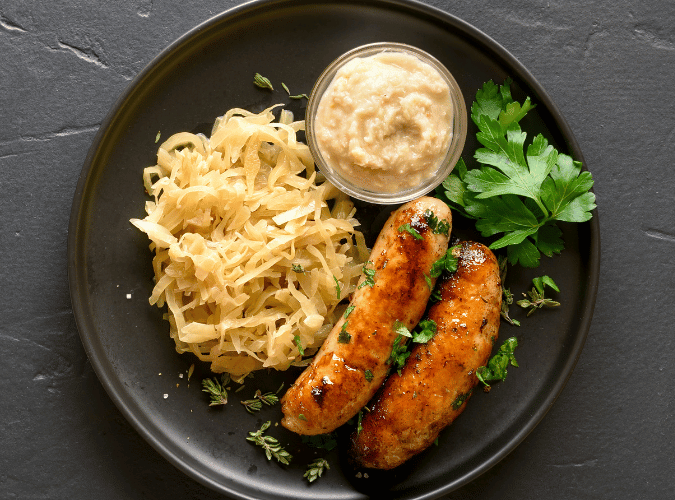UPDATE: Meanwhile, Munich Regional Court I ruled in favor of the bratwurst manufacturer.
An exciting case is currently occupying the judiciary in Bavaria. The question: Is the Ostermeier company from Geiselhöring allowed to produce and sell mini grilled sausages, even though they look confusingly similar to the original Nuremberg bratwurst?
In the Trademark law there are some specialized disciplines that rarely receive attention. These include the Indications of origin such as "protected geographical indications" and "protected designations of origin".
Known protected designations of origin are champagne, Parma ham or feta. Behind these names are complex sets of rules that define exactly when, for example, a Parma ham can be called that. It is precisely specified where the pig must come from, how and where it may be dried, how long it must mature and much more. According to a recent court ruling, Parma ham must even be sliced in Parma, for example. A Scotch can only be called Scotch if everything about the product really does come from Scotland, including the bottle and the label.
Here are a few examples:
Cheese:
- Allgäuer Bergkäse PDO: Matured for at least four months, only from milk from the Allgäu region
- Bavarian blue cheese PDO: Matured for at least 30 days, only from milk from Bavaria
- Odenwälder Frühkäse PDO: use of regional ingredients, traditional production
Meat and sausage products:
- Swabian spaetzle PDO: use of eggs, flour, salt and water, produced according to a traditional recipe
- Nuremberg Rostbratwurst PDO: pork, beef, marjoram, salt and pepper, max. 9 cm long
- Thüringer Rostbratwurst PDO: pork, beef, marjoram, salt and pepper, at least 7 cm long
Fruit and vegetables:
- Holsteiner Cox PDO: apple variety with a tart taste, grown in the Holsteiner Hügelland region
- Badischer Spargel PDO: Asparagus with a white skin end, grown in the Rhine plain
- Apples from the Altes Land PDO: Various apple varieties, grown in the Altes Land on the Elbe
Other foods:
- Dresdner Christstollen PDO: yeast dough with raisins, almonds and candied lemon peel, special shape
- Freiburger Münsterkäse PDO: Soft cheese with a mild, creamy taste, produced in Freiburg
- Lübeck marzipan PDO: use of almonds, powdered sugar and rose water, at least 70% almond content
Things are a little less strict with the protected geographical indications to: here it is often sufficient that part of the production process took place in the region of origin. There are also usually no strict regulations on how the product may be processed.
The protected designations are entered in the European "Register of Protected Designations of Origin and Protected Geographical Indications", or "EU Quality Register" for short.
The protected geographical indication "Nürnberger Rostbratwürstchen"
There are also clear rules for "Nürnberger". A Nuremberg Rostbratwurst is a "7-9 cm long sausage in a tight sheep casing with a medium-coarse grain". The mincing of the meat, the mixing of meat and spices and the filling of the sausages must all take place in Nuremberg.
Do mini sausages infringe the right to a Nuremberg bratwurst?
The legal dispute centers on the question of whether the "Mini Rostbratwürstchen" sausages from the Ostermeier company in Geiselhöring violate the EU "Protected Geographical Indication" label for Nuremberg sausages. The Schutzverband Nürnberger Bratwürste, chaired by Rainer Heimler, argues that the small sausages evoke an association with the Nuremberg originals due to their size, the packaging design and the use of marjoram and therefore violate trademark law. The name "Nürnberger" is not used anywhere by the Ostermeier company.
Heimler bases his argument on a survey, according to which 45% of respondents associated Ostermeier sausages with Nuremberg. He also criticizes the use of images on the packaging, which are very similar to Nuremberg sausages in their traditional preparation with sauerkraut and a rustic pot. Both the Nuremberg sausages and the "Mini Rostbratwürstchen" have characteristic speckles of marjoram. He sees Ostermeier's approach as deliberate "misdirection" in order to profit from the reputation of Nuremberg sausages. He argues that the Nuremberg sausage format should be reserved exclusively for Nuremberg producers in order to protect the strict specifications for ingredients and quality.
The other side rejects the accusations. It emphasizes that there is no direct reference to Nuremberg in the name of the Ostermeier product and that the similarity in size and appearance is purely coincidental. The "Mini Rostbratwürstchen" are said to differ in taste from the Nuremberg sausages. The plaintiff's survey is methodologically flawed and therefore not meaningful.
Munich Regional Court I sees an "exciting case"
According to the press office of Munich Regional Court I, there is no comparable case law. The outcome was therefore left completely open. The court would like to make a decision on May 7, 2024. The ruling could have far-reaching consequences for the entire bratwurst market. If the Nuremberg Bratwurst Protection Association prevails against Ostermeier, this could lead to a wave of lawsuits against other manufacturers of Nuremberg-style sausages.
Conclusion: The legal dispute surrounding the Nuremberg bratwurst and the "Mini Rostbratwürstchen" raises exciting questions about trademark law, consumer protection and regional identity. The verdict of the Munich Regional Court will point the way for the future of the traditional Nuremberg bratwurst.

